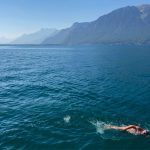Can we have this in the UK please?
Here’s an idea for how local authorities in seaside towns can support open water swimming. Firstly, identify a suitable swimming route. Ideally this should be between around 500m and 2km with start and finish points at a beach or somewhere with easy access to the water. The routes should preferably run parallel to coastal paths in a places of outstanding natural beauty. Secondly, mark off the swimming area with a set of bright yellow buoys to prevent boats and jet-skis from entering. Next, put up a big information sign describing the route and pointing out some of the things (e.g. plants, fish, birds and rock formations) you might see as you swim. Warn swimmers that there are no life-guards, that they are swimming at their own risk and advise them to take sensible precautions such as using a tow-float and swimming with others. As an optional extra, create partnerships with local leisure providers (e.g. kayak or surf hire outlets) so that swimmers have somewhere near the start they can leave their kit and ask for advice. Finally, sit back and enjoy a boost in visitor numbers as swimmers come to enjoy the sea.
Does this sound fanciful? Can you imagine local authorities encouraging swimmers to stray outside of closely life-guarded areas between two flags? Could they get comfortable with people swimming at their own risk?
In Spain they can. Jonathan and I have just spent three days with Vies Braves exploring their ‘sea swimming lanes’ along the Costa Brava and in and around Barcelona. It’s a brilliant scheme, and we had a great time.
Mostly we didn’t ‘swim’. Rather, we explored the coastline from the water, pottering along, sinking down to take a closer look at interesting things on the sea bed or darting in and out of rocky coves. At one point we dived through an underwater tunnel and popped up in a tiny rock pool. Sometimes we did just swim too. For example, parallel to Barceloneta Beach, where there was little to see under the water. However, in most places the water was so clear and sea life so vibrant that it would have been a shame to race past.
The sea lanes are open from around the end of May (in some cases a little later) until around October. In mid summer the water temperature is often well into the 20s so you can linger without a wetsuit. It was around 17 to 19 degrees while we were there so we put on wetsuits for a couple of the longer swims but mostly swam without quite comfortably. Some of the ‘lanes’ are close enough to each other that you can walk (or run) between them along coastal paths and complete several in a day. Others run alongside nature reserves with coastal paths so non-swimming friends can walk alongside or you could pack some clothes in a dry-bag and walk back.
There are a few hazards to watch out for. A few start from rocky beaches so a pair of flip flops is useful. We encountered a couple of jellyfish and Jonathan got stung once. He also brushed his hand over a sea urchin and got a spine in his finger. Close to the cliffs the water can be quite turbulent and you need to watch out for rocks close to the surface. Being the Mediterranean, the tidal range is small and the swims aren’t affected by tidal currents but the area can become very windy, which can make swimming conditions difficult. You are advised to check the weather forecast before swimming.
Generally though, the swimming is extremely safe. In fact, one of the motivations for the project was to improve the safety for swimmers. In some areas, in the past, swimmers would mingle freely with boats – and in Spain, in summer, there are a lot of boats – and the sea lanes encourage swimmers to keep away from heavily trafficked areas.
The best thing, from our perspective, is that the project puts swimming on an equal footing with other recreational activities, such as walking, that are supported by the local authorities. It’s not seen as a fringe activity for extremists and eccentrics but a regular, everyday sport that can and should be accessible to anyone.
We’d love to see the concept take off in the UK too.
Find out more: www.viesbraves.com







